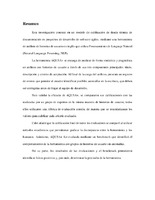Modelo para la identificación de deuda técnica de documentación en ambientes de desarrollo de software ágiles
Resumen
This research is about a model that identifies and evaluates technical documentation debt in agile software development projects, using a Natural Language Processing (NLP) based tool called AQUSA+.
The tool analyzes a set of user stories syntactically and pragmatically through their three main components: title, description and acceptance criteria. It allows the user to load a file and then display all the errors that need to be corrected in their textual composition, which may lead to technical debt accumulation.
To validate the performance, AQUSA+ scores were compared to the ones of a set of experts, who used the same sample of user stories and the same evaluation rubric, in order to standardize the values of each quality criteria score.
The final score for each evaluator was graphically displayed, in order to statistically compare it to the one from the tool. Also, a benchmark with a set of user stories with no errors was run on the tool to analyze any unexpected behavior.
The evaluations and the benchmark allowed us to identify false positives, and thus to calculate the precision of the tool
Descripción
Proyecto de Graduación (Maestría en Computación) Instituto Tecnológico de Costa Rica, Escuela de Ingeniería en Computación, 2017.
Compartir
Métricas
Colecciones
- Maestría en Computación [113]


